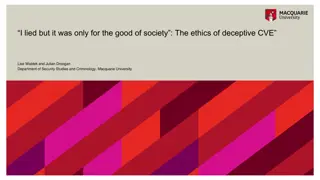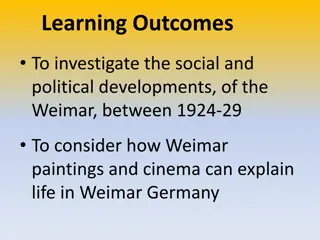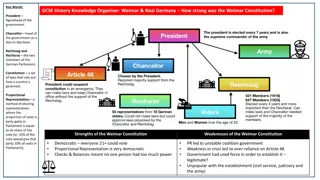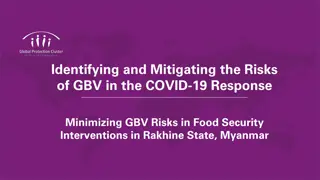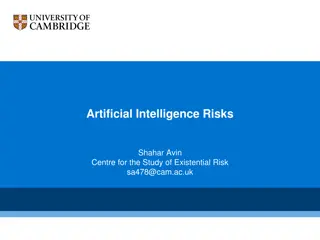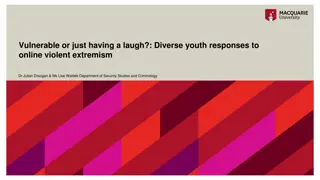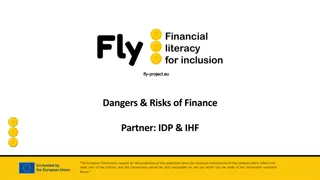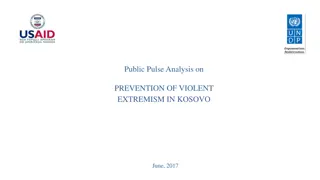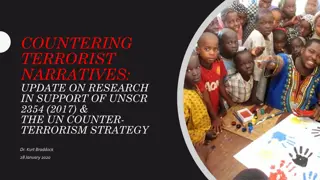Understanding Extremist Risks: Insights and Strategies
Explore the complexities of extremist risk through a lens of psychological and contextual analysis. Delve into the nature of terrorism, different types of terrorism, and the importance of robust risk assessment in preventing, pursuing, protecting, and preparing against terrorist activities.
Download Presentation

Please find below an Image/Link to download the presentation.
The content on the website is provided AS IS for your information and personal use only. It may not be sold, licensed, or shared on other websites without obtaining consent from the author. Download presentation by click this link. If you encounter any issues during the download, it is possible that the publisher has removed the file from their server.
E N D
Presentation Transcript
Adjusting your lens: Thinking about extremist risk Dr Leanne Gregory, Senior Clinical Psychologist, CYCJ Associate IVY Conference, Glasgow, December 3rdand 4th2015
Conceptualisation Lessons from the Literature Challenges Context Risk Assessment Learning Points
.use or threat of action designed to influence the government or its agencies; or to intimidate the public; and is driven by political, religious or ideological agendas. The nature of the threat or action involves serious violence against a person, serious damage to property, endangers a person's life, other than that of the person committing the action, creates a serious risk to the health or safety of the public or a section of the public, or is designed seriously to interfere with or seriously to disrupt an electronic system (Terrorism Act).
Type Objective Example Criminal Terrorism Further Criminal Goals Narcoterrorists assassinate legal officials Political Terrorism State State turns on own Further political agenda, change Argentina bloody wars ; Sadam Hussain s regime; Libya Red Army; Weather Underground; extreme environmentalists 1998 - 929 2009 - 4715 2013 - 11952 Political Terrorism Sub state Social revolution Overthrow prevailing, usually capitalist, order Political Terrorism Substrate National Separatist Religious Terrorism Response to social injustice IRA; ETA Further religious ends Al-Queda; ISIS
Contest (Home Office, 2011) Prevent: Pursue: Protect: Prepare: ROBUST RISK ASSESSMENT IS NEEDED TO SUCCESSFULLY FULFIL PREVENT S BRIEF prevent people from being drawn into terrorism and to work across sectors and institutions where there are risks of radicalisation detect threats at earliest stage, disrupt activity before it can endanger the public, prosecute those responsible strengthen national protection against terrorist attacks in the UK or against UK interests overseas seeks to mitigate the impact of a terrorist attack in the event that it cannot be stopped
CHALLENGES THIS IS WHERE WE ARE OPERATING
SERIOUSNESS + GROWING FREQUENCY + CHALLENGES TO RISK ASSESSMENT + OUR OWN FEELINGS & BIASES + INFANT LITERATURE + + = What am I supposed to do about this?!?
THINKING SKILLS ANXIETY
many terrorisms exist, and their character has changed over time and from country to country. The endeavour to find a general theory of terrorism, one overall explanation of its roots, is a futile and misguided enterprise Lacquer (2003)
LESSONS FROM THE LITERATURE Mental illness is not a critical factor explaining VE behaviour. Most terrorists are not psychopaths. There is no such things as a terrorist personality. most serious researchers in the field at least nominally agree with the position that terrorists are essentially normal individuals (Silke, 1998). Childhood maltreatment is common in the biographies of terrorist. Perceived injustice/humiliation are important themes. Need for identity and belonging are common vulnerabilities. Motives are hugely varied and not stable over time. Individual risk cannot be divorced from the context of the in-group, and the political context of the time. Becoming a terrorist is rarely a conscious decision social process. Opportunity is an important factor. Know little about recruitment. Seems geared towards deprived and dissatisfied. Role of culture is poorly understood, as are operations, and behaviour in the group. Terrorists have different roles and become terrorists via differing pathways and for different reasons. In understanding risk, it might be helpful to distinguish between the reasons for joining, remaining in, and leaving group.
Background Communication Risk Factors STRUCTURED PROFESSIONAL JUDGEMENT RISK ASSESSMENT Management Formulation Scenarios
Ideology Emotional Factors Capability EXTREMIST RISK ASSESSMENT Silke (2014) Disengagement Factors Affiliations Political and Social Environment
Extremism Risk Guidance 22 + (ERG22+) (Rehabilitation Services Group, 2011) Risk Factors Violent Extremist Risk Assessment (VERA-2) (Pressman & Flockton, 2010, 2012a)
Adam is a 17-year-old Caucasian male. Concerns were raised within two weeks of first term as he had taken-up position at the entrance where he stood each morning, lunchtime and evening distributing home-made leaflets promoting right wing politics. He was also reported to occasionally make statements in class about blowing the place up . As a result of his behaviour, he had been charged with dissemination of terrorist materials, and asked to leave college. However, he persisted and returned each day but stood outside the campus grounds where he continually espoused his views. He was highly aggrieved with the college and further education establishments for promoting multi-cultural society and for, what he termed, giving supremacy to foreign nationals. He distributed leaflets to this effect whilst dressed in a military- type uniform. Through his activities, he managed to recruit supporters and very quickly, he progressed from being something of a lone voice to having several supporters stand alongside him. His mother disclosed to police that he had told her that, alongside peers, he had been planning and incident he referred to as a the most amazing one yet . There were many email interchanges to this effect and, when his computer was analysed, a detailed and specific plan was found. He had also been attempting to source materials for making firebombs and computer record analysis indicated historical searches regarding bomb-making. Adam has two known incidents of interpersonal violence at school earlier in his adolescence, which reportedly involved him pushing and hitting peers in response to misunderstandings.
Ideology Emotional Factors Capability EXTREMIST RISK ASSESSMENT Disengagement Factors Affiliations Political and Social Environment
STRUCTURED ASSESSMENT VIOLENCE RISK IN YOUTH (SAVRY) Emotional Factors Disengagement Factors
Affiliations Ideology Capability VIOLENT EXTREMISM RISK ASSESSMENT (VERA) Emotional Factors Ideology Capability Disengagement Factors
LEARNING POINTS Terrorists are a highly, highly idiosyncratic group. There is no single pathway into terrorism. The empirical evidence regarding risk assessment of violent extremism is in its infancy, with no validated tools available. As such, methods are limited but there is promise. Case by base highly individualised risk assessment is required. Cognisance of in-group is important, as is acknowledgement of socio-political context. We need to look to the literature, teach ourselves. SPJ paradigm can tolerate the demands of the assessment. VERA, and other VE sensitive tools are a welcome addition to risk assessment methodologies. We need to consult with experts in a particular terrorist movement. Given the breadth of information needed to capture the risk domains, multiagency working and information sharing is key. This is anxiety provoking. Help yourself to think, liaise with your colleagues, get supervision, work jointly.





